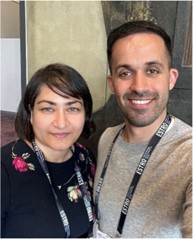Insights from ESTRO 2024
ESTRO 2024 Congress report
This report provides a summary of presentations made during ESTRO 2024 that were dedicated to skin cancer and soft-tissue sarcoma (STS).
Of all 201 sessions at ESTRO 2024, only two (2%) were dedicated to skin cancer and another two (2%) to STS. The two symposia on skin cancer comprised seven oral presentations, one mini-oral presentation, and eight posters. The two focusing on STS comprised three posters and five mini-oral presentations.
Skin cancer
Chyrek and Joshi presented the existing guidance for the treatment of non-melanoma skin cancer (NMSC) with a preference for Brigham and Women's Hospital (BWH) staging, which provides better prognostication and correlation with clinical outcomes (Karia et al., JCO 2014). To refine the post-operative radiotherapy recommendation for intermediate-risk BWH T2b cutaneous squamous cell carcinomas, Joshi discussed gene expression profiles, which in selected circumstances may identify those who are staged and managed as intermediate risk, but remain at high risk of cancer relapse.
In the symposium, Vassiliou, an expert in and active member of the European Organisation for the Research and Treatment of Cancer (EORTC) quality of life (QoL) group, detailed the functional and cosmetic impact of the non-surgical treatment of NMSC. Current QoL tools are not focused on the impact of cancer treatment. Work is ongoing in the EORTC QoL and the ESTRO skin and soft-tissue focus groups to improve the available tools so that patients may make more informed choices regarding their care.
In the mini-oral session, Braendstrup et al. presented patient- and physician-reported outcomes from the Danish national prospective analysis of 897 patients with basal cell carcinoma who had been treated with 70-100kV radiotherapy. They reported that 97% of patients had been satisfied or very satisfied after six months of treatment, with no impact detected from variations in dose-fractionation schedules.
This year ESTRO hosted the first joint European Association of Dermato-Oncology (EADO)-ESTRO symposium. EADO was represented by Professor Ketty Peris, Professor of Dermatology and Secretary-general of EADO. The symposium ratified the EADO-ESTRO memorandum of understanding, which will strengthen efforts to promote effective cancer care across the organisations. The symposium included all disciplines that are involved in skin cancer treatment and addressed challenging circumstances in this often older patient population. Professor Peris outlined the benefit of cemiplimab immunotherapy, which confers a 47.2% overall response rate with 20% complete remission; immunotherapy is a valuable tool in the multi-disciplinary treatment of complex skin cancer.
Putora et al. were unable to present in person at ESTRO 2024 on decision-making methodology in NMSC. Although guidelines are established, the guidelines for post-operative radiotherapy in NMSC have a very limited amount of high-level evidence. Putora invited 19 ESTRO-nominated radiation oncologists with expertise in skin cancer to formulate decision trees that detailed their recommended management in the post-operative radiotherapy setting. There is a very wide range of decision-making criteria in clinical use, with significant discrepancies in treatment recommendations and delivered dose-fractionation schedules. Putora’s findings will be published this year.
Barnes et al. presented a virtual poster that showed the prevalence and trends in skin cancer abstracts that had been presented at the last eight annual ESTRO congresses; skin cancer research and education are very poorly represented at the annual ESTRO congresses, representing only 0.5% of accepted abstracts.
Soft-tissue sarcomas
Hypofractionation in preoperative radiotherapy for STSs of the extremities/trunk wall is an emerging field with promising single-arm phase II studies.
In the mini-oral sarcoma/skin cancer/malignant melanoma session, Spałek et al. gave an update on the prospective phase II study from the Warsaw Cancer Center that involves the use of 5x5Gy combined with doxorubicin and ifosfamide for marginally resectable STS. With a median follow-up of 34 months in 82 patients with very large STSs (median size 15.2cm), remarkable R0 resection rates of 73% were achieved. Major wound complication rates were comparable with those reported during conventional fractionation in the landmark SR-2 trial (O'Sullivan et al.) and the most common grade 3 toxicity was haematological toxicity that was related to chemotherapy. Similarly, Chander et al. applied 5x4Gy with a simultaneously integrated boost to the tumour core of 5x10Gy over two weeks in a patient cohort with very large, unresectable STSs and poor performance status. Although the study was retrospective and had a small sample size (n=14), the outcomes of 88.9% partial responses, a 49.5% reduction in tumour sizes, and 100% symptomatic responses warrant prospective validation. The results suggest a curative alternative to the often end-of-line and palliative treatment modalities in this very challenging and often difficult-to-treat patient cohort.
Hanafi et al. presented single-centre retrospective data on 128 patients from McGill University (Montreal, Canada) who had received either preoperative conventional fractionated or hypofractionated radiotherapy. This retrospective study was the first in which pathological response rates between hypofractionated and conventionally fractionated radiotherapy were compared. Hypofractionation was associated with higher pathological response rates. Pathological response, in turn, was associated with improved distant-disease-free survival, thereby confirming strong data from previous studies by Wang et al. (JAMA Oncology 2023). Although head-to-head data from the Dutch prospective randomised SCOPES trial (NCT04425967) are pending, this study again implies an at least equal tumour response when hypofractionation is used.

Dr Siyer Roohani, MD
Department of Radiation Oncology
Charité - University Medicine Berlin and Berlin Institute of Health
Berlin, Germany
siyer.roohani@charite.de
Dr Romaana Mir, MB ChB MSc FRCP FRCR MD(Res)
Mount Vernon Cancer Centre
Northwood, UK
Secretary, ESTRO skin and soft tissue focus group
romaana.mir@nhs.net